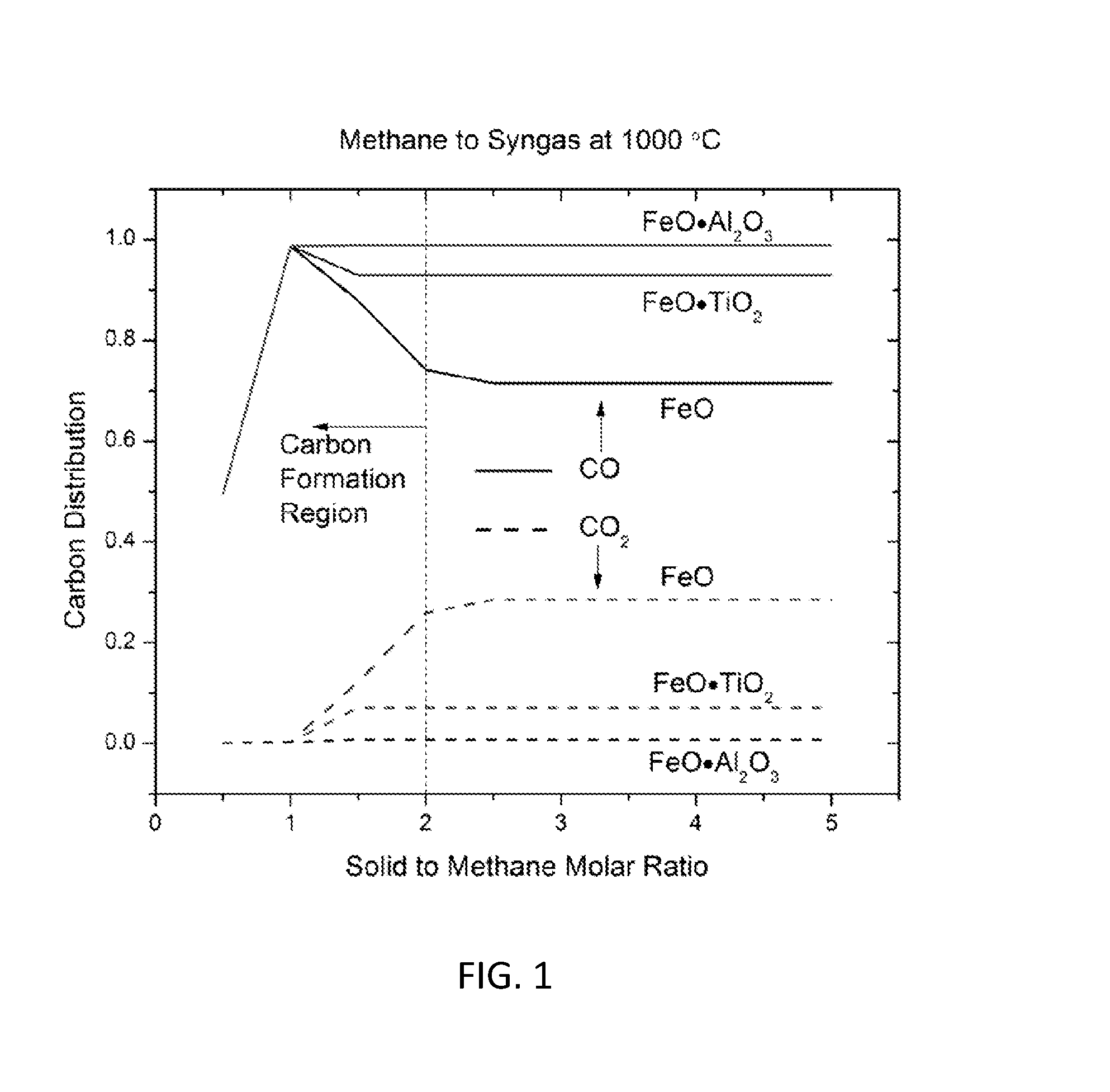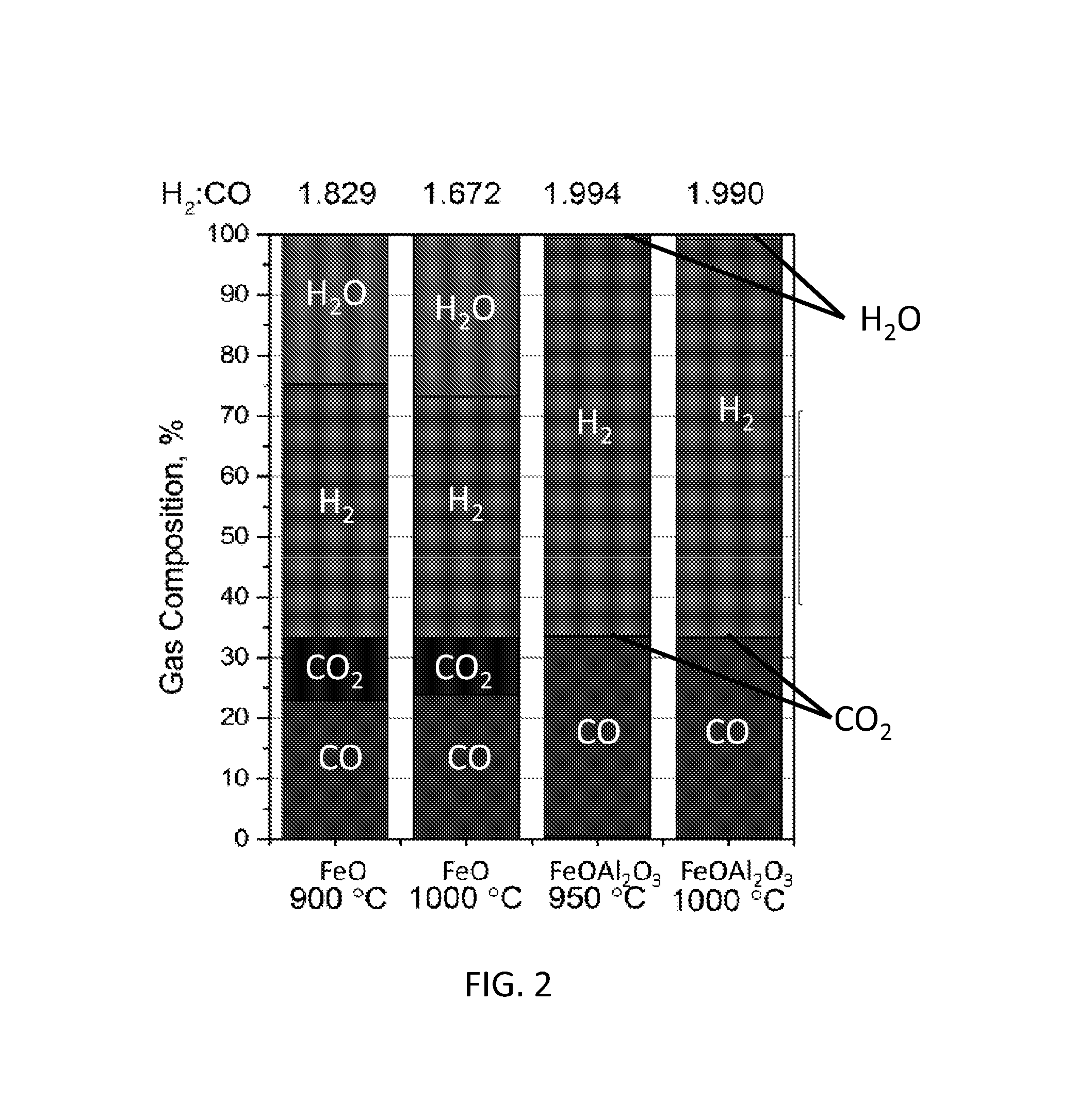Methods for fuel conversion
a fuel conversion and fuel technology, applied in the direction of energy input, molten salt/metal gasification, organic chemistry, etc., can solve the problems of large carbon dioxide emission into the environment, significant capital and operational costs,
- Summary
- Abstract
- Description
- Claims
- Application Information
AI Technical Summary
Benefits of technology
Problems solved by technology
Method used
Image
Examples
example 1
[0067]A fixed bed experiment was conducted to study the methane to syngas reaction. The lower section of the reactor was filled with 23.1 g FeO—TiO2 particles, and the upper section was filled with 8.3 g Fe2O3—TiO2 particles. When the temperature of the reactor reached 990° C., 50 mL / min CH4 and 50 mL / min N2 was injected into the reactor by digital mass controllers. The outlet gas composition was analyzed using a CAI gas analyzer as well as a gas chromatography. The gas concentration at the outlet reached a quasi-steady state in half an hour with methane conversion >95%, CO:CO2 ratio around 10, CO:H2 ratio around 1:2.
example 2
[0068]A moving bed reactor test apparatus was constructed, as shown in FIG. 12, and experiments were conducted to study the solid feedstock to syngas reaction using Powder River Basin (PRB) coal as prototype coal. The PRB coal tested has about 25% moisture and the corresponding molecular formula may be CH0.8O0.2 on a dry basis. The coal powder was mixed with particles at the mass ratio of 1:5 and then fed into the moving bed system from the top in a batch mode. The solid flowrate was controlled to be 20 g / min by the screw feeder at the bottom. The temperature was controlled by the external heating to be 1030° C. At the steady state, the coal conversion is over 90%, H2 / CO ratio fluctuated between 0.5-0.7 and CO / CO2 ratio fluctuated between 5-12, as shown in FIG. 13, respectively. The fluctuation is due to the batch feeding mode of the solid material. Furthermore, CH4 was also co-injected to adjust the H2 / CO ratio. The co-injection of CH4 (870 ml / min, coal 2.7 g / min, particles 20 g / mi...
example 3
[0069]A moving bed reactor test was conducted to study the solid feedstock conversion to syngas using biomass. The corresponding molecular formula was CH1.4O0.6. The biomass material was mixed with particles at a mass ratio of 1:3 and then injected into the moving bed system from the top. The solid fuel and composite particles followed a co-current contacting mode. The composite particle flowrate was controlled to 20 g / min using the screw feeder at the bottom. The temperature was controlled to 1040° C. using the external heaters. At steady state operation, the biomass conversion was over 95% with CO:CO2 ratio around 10 and CO:H2 ratio around 1:0.8. In this case, the carbon monoxide and hydrogen concentration in the high quality syngas from the syngas production reactor was higher than 91 mol %. Additionally, CH4 was co-injected to adjust the CO:H2 ratio. The co-injection of CH4 (540 ml / min, biomass 5 g / min, particles 26 g / min) gave an almost complete fuel conversion (95%) with CO:H2...
PUM
| Property | Measurement | Unit |
|---|---|---|
| temperature | aaaaa | aaaaa |
| temperature | aaaaa | aaaaa |
| temperature | aaaaa | aaaaa |
Abstract
Description
Claims
Application Information
 Login to View More
Login to View More - R&D
- Intellectual Property
- Life Sciences
- Materials
- Tech Scout
- Unparalleled Data Quality
- Higher Quality Content
- 60% Fewer Hallucinations
Browse by: Latest US Patents, China's latest patents, Technical Efficacy Thesaurus, Application Domain, Technology Topic, Popular Technical Reports.
© 2025 PatSnap. All rights reserved.Legal|Privacy policy|Modern Slavery Act Transparency Statement|Sitemap|About US| Contact US: help@patsnap.com



